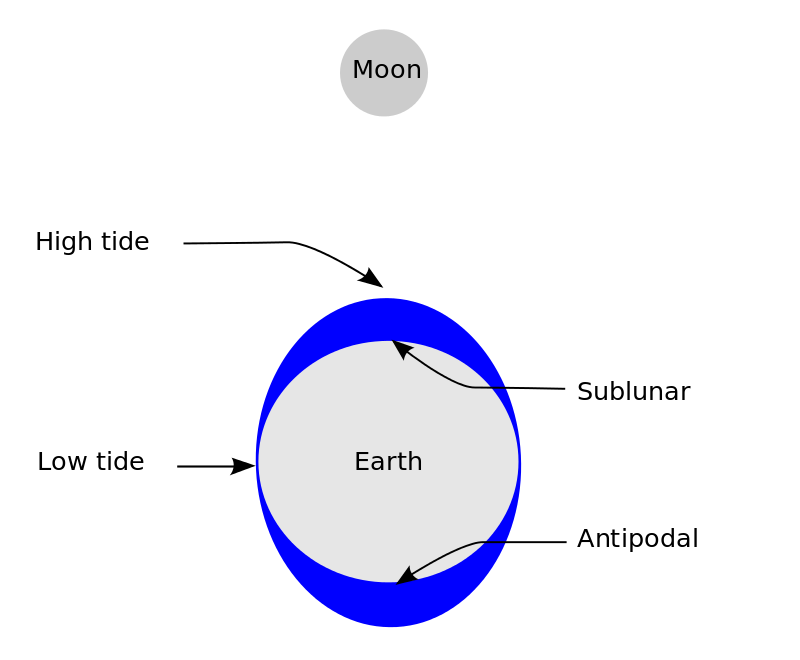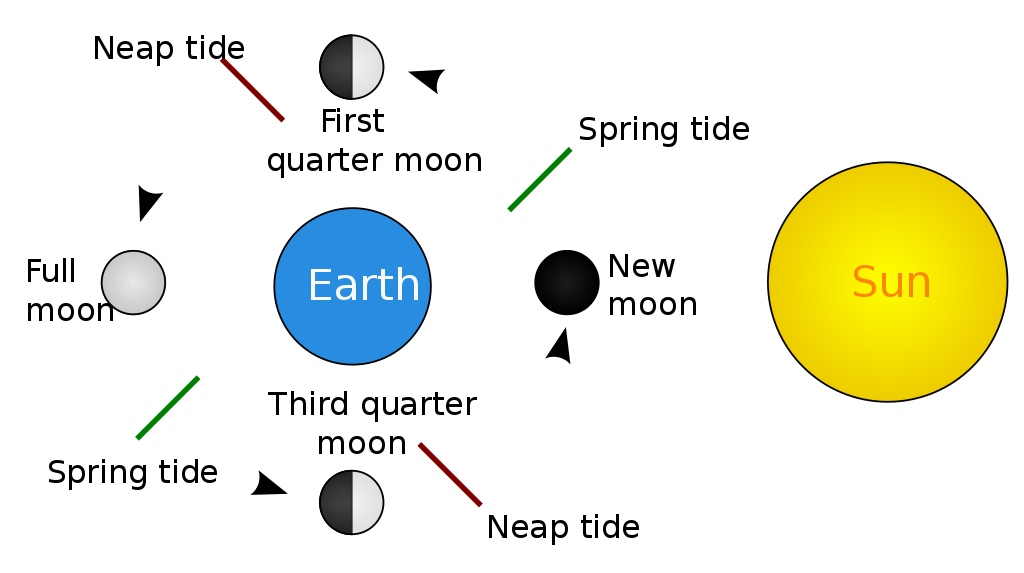The periodical rise and fall of the sea level, once or twice a day, mainly due to the attraction of the sun and the moon, is called a tide.
The movement of water caused by meteorological effects (winds and atmospheric pressure changes) are called surges. Surges are not regular like tides. The study of tides is very complex, spatially and temporally, as it has great variations in frequency, magnitude, and height.
The moon’s gravitational pull to a great extent and to a lesser extent the sun’s gravitational pull, are the major causes for the occurrence of tides.

Another factor is centrifugal force, which is the force that acts to counterbalance gravity. Together, the gravitational pull and the centrifugal force are responsible for creating the two major tidal bulges on the earth.
On the side of the earth facing the moon, a tidal bulge occurs while on the opposite side through the gravitational attraction of the moon is less as it is farther away, the centrifugal force causes a tidal bulge on the other side.
The ‘tide generating force is the difference between these two forces; i.e. the gravitational attraction of the moon and the centrifugal force.
On the surface of the earth, nearest the moon, pull or the attractive force of the moon is greater than the centrifugal force, and so there is a net force causing a bulge towards the moon. On the opposite side of the earth, the attractive force is less, as it is farther away from the moon, the centrifugal force is dominant.
Hence, there is a net force away from the moon. It creates the second bulge away from the moon. On the surface of the earth, the horizontal tide generating forces are more important than the vertical forces in generating the tidal bulges.
The tidal bulges on wide continental shelves have greater height. When tidal bulges hit the mid-oceanic islands they become low.
The shape of bays and estuaries along a coastline can also magnify the intensity of tides. Funnel-shaped bays greatly change tidal magnitudes. When the tide is channeled between islands or into bays and estuaries they are called tidal currents.
Types of Tides
Tides vary in frequency, direction, and movement from place to place and also from time to time. Tides may be grouped into various types based on their frequency of occurrence in one day or 24 hours or based on their height.
Tides based on Frequency
Semi-diurnal tide
The most common tidal pattern, featuring two high tides and two low tides each day. The successive high or low tides are approximately the same height.
Diurnal tide
There is only one high tide and one low tide during each day. The successive high and low tides are approximately the same height.
Mixed tide
Tides having variations in height are known as mixed tides. These tides generally occur along the west coast of North America and on many islands of the Pacific Ocean. Tides based on the Sun, Moon, and the Earth Positions.
The height of rising water (high tide) varies appreciably depending upon the position of the sun and moon with respect to the earth. Spring tides and neap tides come under this category.

Spring tides
The position of both the sun and the moon in relation to the earth has a direct bearing on tide height. When the sun, the moon, and the earth are in a straight line, the height of the tide will be higher.
These are called spring tides and they occur twice a month, one on the full moon period and another during the new moon period.
Neap tides
Normally, there is a seven-day interval between the spring tides and neap
tides. At this time the sun and moon are at right angles to each other and the forces of the sun and moon tend to counteract one another.
The Moon’s attraction, though more than twice as strong as the sun’s, is diminished by the counteracting force of the sun’s gravitational pull.
Once in a month, when the moon’s orbit is closest to the earth (perigee), unusually high and low tides occur. During this time the tidal range is greater than normal.
Two weeks later, when the moon is farthest from Earth (apogee), the moon’s gravitational force is limited and the tidal ranges are less than their average heights.
When the earth is closest to the sun (perihelion), around 3rd January each year, tidal ranges are also much greater, with unusually high and unusually low tides. When the earth is farthest from the sun (aphelion), around 4th July each year, tidal ranges are much less than average.
The time between the high tide and low tide, when the water level is falling, is called the ebb. The time between the low tide and high tide, when the tide is rising, is called the flow or flood.
Importance of Tides
Since tides are caused by the earth-moon-sun positions which are known accurately, the tides can be predicted well in advance. This helps the navigators and fishermen plan their activities.
Tidal flows are of great importance in navigation. Tidal heights are very important, especially harbours near rivers and within estuaries having shallow ‘bars’ at the entrance, which prevent ships and boats from entering into the harbour.
Tides are also helpful in desilting the sediments and in removing polluted water from river estuaries. Tides are used to generate electrical power (in Canada, France, Russia, and China). A 3 MW tidal power project at Durgaduani in Sunderbans of West Bengal is underway.

